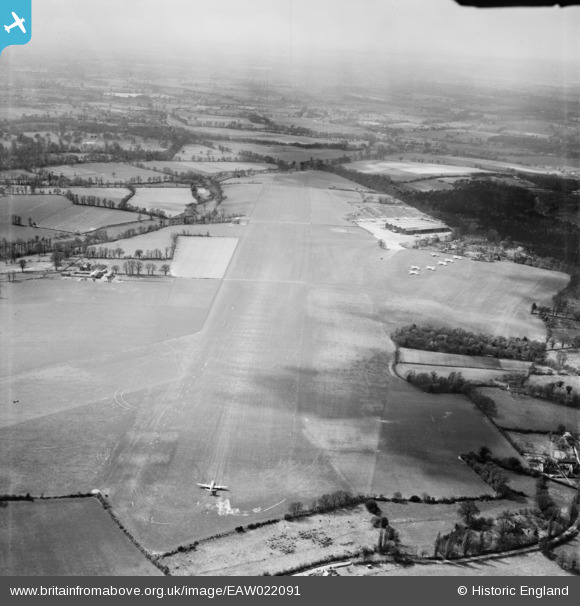 Vickers V.630 Viscount prototype, wearing military markings and serial VX211.
It was previously registered G-AHRF and first flew on 16 July 1948. In November 1948, military roundels and serial VX211 were applied - it wore these until 19 August 1949, when it reverted to civil registration G-AHRF. On 27 August 1952, it was damaged beyond economic repair, when the starboard main undercarriage leg collapsed during a landing at Khartoum Airport, Sudan. |

David Eyre |
Saturday 16th of May 2020 06:41:10 AM |
 Ripley Village on A3. |

Maurice Ungless |
Sunday 5th of January 2020 05:42:48 PM |
 A3 to Guildford. |

Maurice Ungless |
Sunday 5th of January 2020 05:41:53 PM |
 Junction of A3 and road to Wisley Airfield to left and road to Wisley Gardens Horticultural Centre to right. Now with a footbridge to carry pedestrians from one side to another across the dual carriageway of the A3. |

Maurice Ungless |
Sunday 5th of January 2020 05:38:49 PM |
 A3 road as of that era, now in 2020 a dual carriageway from M25 to Guildford. |

Maurice Ungless |
Sunday 5th of January 2020 05:35:32 PM |
 Small hanger at Wisley that in later years was to house the assembly of the worlds first turbine powered aircraft to fly, the Vickers Viscount 4 engine (dart powered) commercial passenger aircraft. Also the site of the fabrication of the V1000 project but not continued with and scrapped before flight. Was also site of the BAC111 test flights and Vickers Supermarine Scimitar test flying, and was to house the TSR2 test flying, but then scrapped in 1964/5 soon after the first flight at Boscombe Down. Hanger has now been demolished but concrete base still exists as of 2020. |

Maurice Ungless |
Sunday 5th of January 2020 05:32:40 PM |
 Entrance to Wisley airfield and road to right through the woods either side leading to A3. In 1947 the first Vickers Viscount G-AHRF, which was fabricated at Foxwarren, (the experimental section of Vickers Armstrongs Ltd (Weybridge), in fuselage and separate wing forms, plus tail plane and fin structures, was transferred by road down the A3, (a matter of approximately 2 miles), to be subsequently constructed at Wisley in the small hangers & flown for the first time on 16th July 1948. G-AHRF was the worlds first commercial passenger turbine aircraft to fly. |

Maurice Ungless |
Sunday 5th of January 2020 05:23:06 PM |
 Later site of larger hanger to be built circa 1952 for the Vickers Valiant 4 jet bomber for the RAF & subsequently extended in 1963 to accommodate the larger VC10 aircraft with higher fins and tailplanes. Hanger subsequently demolished circa 1975 after closure of Wisley airfield in 1972, but concrete base and dispersal and parking area concrete remains as of 2020. |

Maurice Ungless |
Sunday 5th of January 2020 05:11:23 PM |
 Original Hyde Farm House, utilised as the Control Tower for all subsequent operations over the years until closure of Wisley Airfield in 1972, now demolished. Grass strip was upgraded to a concrete runway circa 1952 and still exists at time of comment 2020. Wisley Airfield was Weybridge based Vickers Armstrongs Ltd (Aircraft) from circa 1945 and was their Aircraft Test Flight Centre for development and pre- delivery checks until closure in 1972. Aircraft development & delivery flying from Wisley was over a period of 25 plus years and aircraft consisted of were :- Vickers Viking, a 1st post war short range commercial passenger transport aircraft. Vickers Viscount, First Flight 16th July 1948 from Wisley, the worlds first short to medium range commercial passenger transport turbine powered aircraft in the world to fly and enter service with many airlines throughout the world, a total of 444 being built. Vickers Valiant, first flight 18th May 1951 from Wisley, the first of the 3 "V" bombers for the RAF, one of the first post WW2, 4 turbojet heavy "V" bombers to fly, of which 107 airframes were built. Vickers Vanguard, a 4 engine turbo prop aircraft operated by BEA & Trans Canada Airlines, a larger successor to the Viscount. 44 airframes completed, 43 delivered. G-AOYW being the prototype that never entered service, which first flew on 20th January 1959. Vickers Standard & Super VC10 a 4 turbojet long range rear engine aircraft, the largest aircraft to be built in the UK and enter service. First flight for Standard VC10 G-ARTA from Weybridge was 29th June 1962 to subsequently land at Wisley. First flight for the Super VC10 G-ASGA, an extended version, was 7th May 1964, and again subsequently to land at Wisley. A total of 54 VC10 airframes were built in various types & configurations at Weybridge before flying to Wisley. BOAC took delivery of the majority of production, plus the RAF & BUA, plus 3 or 4 other airlines. The BAC111 Twin Jet short range passenger aircraft being produced at the then BAC factory at Hurn and first flight from Hurn of G-ASHG was on 20th August 1963. The test flying development was based at Wisley and 2 months later on 22nd October 1963 was on a test flight from Wisley when it crashed on Salisbury Plain killing all on board. A further aircraft to be developed from Wisley was the Twin Jet Fighter Aircraft Carrier born Vickers Supermarine Scimitar during the late 50's, which entered service with the Fleet Air Arm. |

Maurice Ungless |
Sunday 5th of January 2020 05:05:24 PM |
 Vickers Vikings. |

ken |
Wednesday 29th of July 2015 07:59:55 PM |
 Vickers Viscount |

ken |
Wednesday 29th of July 2015 07:58:50 PM |
This actual photo is of Vickers Viscount G-AHRF, the worlds very first commercial passenger turbine aircraft to fly. First flight of this aircraft was from Wisley on 16th July 1948.
Photo taken in 1949 was during the many flight trials of that aircraft, so is very special in that fact, it was the only one flying at the time having first flown on 16th July 1948 and has the roundels on the top of it's wings of the Ministry of Supply that it was registered to at the time. It's C/N number is 1, C/N 2 flew in March 1950 and C/N 3 also flew later in 1950. |

Maurice Ungless |
Sunday 5th of January 2020 05:57:33 PM |














![[EAW022091] Wisley Airfield, Ockham, from the east, 1949](http://britainfromabove.org.uk/sites/all/libraries/aerofilms-images/public/100x100/EAW/022/EAW022091.jpg)
![[EAW022093] Wisley Airfield, Ockham, 1949](http://britainfromabove.org.uk/sites/all/libraries/aerofilms-images/public/100x100/EAW/022/EAW022093.jpg)
![[EAW022096] A Vickers Viscount at Wisley Airfield and Hatchford End, Ockham, 1949](http://britainfromabove.org.uk/sites/all/libraries/aerofilms-images/public/100x100/EAW/022/EAW022096.jpg)